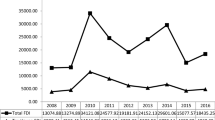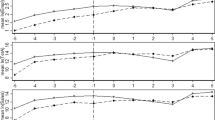Abstract
In 2005, the Government of Ontario, Canada, announced the phase out of the Labour Sponsored Venture Capital Corporation (LSVCC) tax credit, which will become effective in 2011. Some media attention has suggested this might lead to difficulty for Ontario entrepreneurs and emerging firms in raising capital. This study presents evidence from Ontario innovative healthcare firms that capital raising concerns are not related to the phasing out of the LSVCC tax credit, and this evidence is consistent with evidence of extreme underperformance of LSVCCs. However, amongst firms currently funded by LSVCCs, there is significant concern about the phase out of the tax credit, which is at least in part attributable to the terms within LSVCC shareholder agreements. Policymakers should account for firms currently funded by LSVCCs to efficiently facilitate the phase out of the tax credit.

Similar content being viewed by others
Notes
Cosh et al. (2009) show entrepreneurs typically are able to raise the capital they want, but not necessarily in the form that they desire.
Ibid.
Susan Hickman, “Show me the money: The hunt for fresh funding” Ottawa Citizen March 27 2008 http://www.canadait.com/cfm/index.cfm?It=106&Id=26196&Se=0.
Ibid.
YORKbiotech http://yorkbiotech.ca/ is a non-profit organization based in the Greater Toronto Area with a mission to: serve as a gateway to relevant companies and resources; advance entrepreneurship, enhance commercialization, and increase investment; and become the preferred business development partner for regional entrepreneurs and organizations.
It is noteworthy that our response rate of 18.6% compares favourably with previous financial surveys. For example, Brau and Fawcett (2006) obtained a response rate of 19%, and Graham and Harvey (2001) obtained a response rate of 9%. Likewise, these authors emphasize that their response rate is in line with previous financial surveys.
Prior to May 19, 2005, registered Canadian pension plans were limited to investing no more than 30% of their assets in foreign property. See, e.g., http://www.cansofunds.com/current2_may05.htm; http://library.findlaw.com/2005/Jun/15/246359.html. The removal of these limits has the potential effect of, among other things, lowering institutional investment in Canadian private equity funds. As this change might pose a concern to Canadian firms raising capital, and because this change occurred in the same year as the removal of the LSVCC tax credit, this survey question asked for replies to both legislative changes to assess comparative importance to firms raising capital.
R&D/revenues is scaled by 1 in the denominator since some firms did not have revenues.
A co-sale/tag-along right means that if the company wants to sell its shares, the VC can also sell at the same terms. A drag-along right means that if the VC wants to sell then the VC can force other shareholders to sell as well at the same terms.
One concern with the ranking variables is that they may be endogenous. There does not appear to exist suitable instruments; therefore, we present the specifications with and without the ranking variables.
The calculation is \( { \exp }\left( {0.{1} * 0.{139}} \right) - {1} \).
For example, while venture capital-backed firms averaged less than 3% of corporate R&D in the period 1983–1992, it was nevertheless responsible for more than 8% of United States’ industrial innovations in that decade (Kortum and Lerner 2000). See also Hölzl (2009) for related evidence that confirms the importance of R&D for high-growth firms close to the efficient frontier across a sample of 16 European countries.
These terms and conditions are summarized at http://www.sba.gov/INV/overview.html.
Private Equity Comment from SJ Berwin, http://www.sjberwin.com, 8 September 2006.
References
Aghion P, Fally T, Scarpetta S (2007) Credit constraints as a barrier to the entry and post-entry growth of firms. Econ Policy 22(52):731–779
Andersen S, Tian YS (2003) Incentive fees, valuation and performance of Labour Sponsored Investment Funds. Can Invest Rev 16(3):20–27
Armour J, Cumming D (2006) The legislative road to Silicon Valley. Oxf Econ Pap 58:596–635
Armour J, Cumming D (2008) Bankruptcy law and entrepreneurship. Am Law Econ Rev 10:303–350
Bates T (2002) Government as a venture capital catalyst: pitfalls and promising approaches. Econ Dev Q 16:49–59
Brau C, Fawcett SE (2006) Initial public offerings: an analysis of theory and practice. J Finance 61:399–436
Carpentier C, Suret JM (2005) The indirect costs of venture capital in Canada. CIRANO Research Centre. Available at www.cirano.qc.ca/pdf/publication/2005s-25.pdf
Carpentier C, Suret JM (2006) Some evidence of the external financing costs of new technology-based firms in Canada. Venture Cap Int J Entrepreneurial Finance 8:227–252
Carpentier C, L’Her JF, Suret JM (2006) Canadian private equity: nature and evolution. J Priv Equity 9:48–58
Cohen E (2007) Industrial policies in France: the old and the new. J Ind Compet Trade 7:213–227
Connell D (2006) “Secrets” of the world’s largest seed capital fund: how the United States Government uses its Small Business Innovation Research (SBIR) Programme and Procurement Budgets to support small technology firms. Center for Business Research, Cambridge
Cosh A, Cumming DJ, Hughes A (2009) Outside entrepreneurial capital. Econ J 119:1494–1533
Cressy R (2002) Funding gaps: a symposium. Econ J 112:F1–F16
Cumming DJ (2003) The structure, governance and performance of UK venture capital trusts. J Corp Law Stud 3(2):401–427
Cumming DJ (2005a) Capital structure in venture finance. J Corp Finance 11:550–585
Cumming DJ (2005b) Agency costs, institutions, learning and taxation in venture capital contracting. J Bus Venturing 20:573–622
Cumming DJ (2007a) Financing entrepreneurs: Better Canadian policy for venture capital. CD Howe Institute Commentary No 247, CD Howe Institute Press, Toronto
Cumming DJ (2007b) Government policy towards entrepreneurial finance: innovation investment funds. J Bus Venturing 22:193–235
Cumming D (2010) Review essay: public policy and the creation of active venture capital markets, and some comments on "Boulevard of Broken Dreams: Why Public Efforts to Boost Entrepreneurship and Venture Capital Have Failed—and What to Do About It," by Josh Lerner. Venture Capital: An International Journal of Entrepreneurial Finance (forthcoming)
Cumming DJ, Johan SA (2006) Is it the law or the lawyers? Investment covenants around the world. Eur Financ Manag 12:553–574
Cumming DJ, Johan SA (2009) Venture capital and private equity contracting: an international perspective. Elsevier Science Academic Press, San Diego
Cumming DJ, Johan SA (2010) Venture capital and private equity in Canada: phasing out an inefficient tax credit. In: Cumming DJ (ed) Private equity: fund types, risks and returns, and regulation, ch. 24. Wiley Press, New York, pp 579–602
Cumming DJ, Li D (2010) Public policy and business creation in the United States. Working Paper, York University, Presented at American Law and Economics Association, Princeton
Cumming DJ, MacIntosh JG (2006) Crowding out private equity: Canadian evidence. J Bus Venturing 21:569–609
Cumming DJ, MacIntosh JG (2007) Mutual funds that invest in private equity? An analysis of Labour Sponsored Investment Funds. Camb J Econ 31:445–487
Cumming DJ, Walz U (2010) Private equity returns and disclosure around the world. J Int Bus Stud 41:727–754
Denis C, Huizinga H (2004) Are foreign ownership and good institutions substitutes? The case of non-traded equity. CEPR Working Paper DP4339
Gilson R, Schizer D (2003) Understanding venture capital structure: a tax explanation for convertible preferred stock. Harv Law Rev 116(3):875–916
Giot P, Schwienbacher A (2007) IPOs, trade sales and liquidations: modelling venture capital exits using survival analysis. J Bank Finance 31:679–702
Gompers PA, Lerner J (1998) What drives venture capital fundraising? Brookings Proceedings on Economic Activity—Microeconomics. Brookings Institution Press, Washington, pp 149–192
Graham JR, Harvey CR (2001) The theory and practice of corporate finance: evidence from the field. J Financ Econ 60:187–243
Hölzl W (2009) Is the R&D behaviour of fast growing SMEs different? Evidence from CIS III data for 16 countries. Small Bus Econ 33(1):59–75
Jääskeläinen M, Maula M, Murray G (2007) Profit distribution and compensation structures in publicly and privately funded hybrid venture capital funds. Res Policy 36:913–929
Jaffe A, Lerner J (2004) Innovation and its discontents: how our broken patent system is endangering innovation and progress, and what to do about it. Princeton University Press, Princeton
Jeng L, Wells P (2000) The determinants of venture capital funding: evidence across countries. J Corp Finance 6:241–289
Keuschnigg C, Nielsen SB (2001) Public policy for venture capital. Int Tax Public Financ 8:557–572
Keuschnigg C, Nielsen SB (2003a) Tax policy, venture capital and entrepreneurship. J Public Econ 87:175–203
Keuschnigg C, Nielsen SB (2003b) Taxes and venture capital support. Rev Finance 7:515–539
Keuschnigg C, Nielsen SB (2004a) Progressive taxation, moral hazard, and entrepreneurship. J Public Econ Theory 6:471–490
Keuschnigg C, Nielsen SB (2004b) Start-ups, venture capitalists and the capital gains tax. J Public Econ 88:1011–1042
Keuschnigg C, Nielsen SB (2004c) Public policy for start-up entrepreneurship with venture capital and bank finance. Working Paper, University of St. Gallen and Copenhagen Business School
Klapper L, Laeven L, Rajan R (2006) Entry regulation as a barrier to entrepreneurship. J Financ Econ 82(3):591–629
Kooli M, L’Her JF, Suret JM (2006) Do IPOs really underperform in the long-run: new evidence from Canadian market. J Priv Equity 9:48–58
Kortum S, Lerner J (2000) Assessing the contribution of venture capital to innovation. Rand J Econ 31:674–692
Lerner J (1999) The government as venture capitalist: the long-run effects of the SBIR program. J Bus 72:285–318
Lerner J (2002) When bureaucrats meet entrepreneurs: the design of effective ‘public venture capital’ programmes. Econ J 112:F73–F84
MacIntosh JG (1994) Legal and Institutional Barriers to Financing Innovative Enterprise in Canada, Queen’s University Discussion Paper 94–10
Osborne D, Sandler D (1998) A tax expenditure analysis of Labour-Sponsored Venture Capital Corporations. Can Tax J 46:499–574
Poterba J (1989a) Capital gains tax policy towards entrepreneurship. Natl Tax J 42(3):375–389
Poterba J (1989b) Venture capital and capital gains taxation. In: Summers LH (ed) Tax policy and the economy, vol 3. MIT Press, Cambridge, pp 47–67
Sandler D (2001) The tax treatment of employee stock options: generous to a fault. Can Tax J 49:259–302
Soete L (2007) From industrial to innovation policy. J Ind Competition Trade 7:273–284
White H (1980) A heteroskedasticity-consistent covariance matrix estimator and a direct test for heteroskedasticity. Econometrica 48:817–838
World Bank (1994) Can intervention work? The role of government in SME success. World Bank, Washington
World Bank (2002) World Bank Group review of small business activities. World Bank, Washington
World Bank (2004) World Bank Group support for small business. World Bank, Washington
Author information
Authors and Affiliations
Corresponding author
Additional information
For helpful comments and suggestions, we owe thanks to Werner Hölzl and an anonymous referee, and to the seminar participants at the CD Howe Institute, Toronto (November 2008), and the Express Seminar, Stockholm (November 2009). We have benefited from helpful comments and assistance from YORKbiotech, particularly Robert Foldes, Adrienne Ng and Lyudmila Kurochkina. YORKbiotech collaborated in the design of the survey and collected the data reported herein.
Rights and permissions
About this article
Cite this article
Cumming, D., Johan, S. Phasing Out an Inefficient Venture Capital Tax Credit. J Ind Compet Trade 10, 227–252 (2010). https://doi.org/10.1007/s10842-010-0080-3
Received:
Revised:
Accepted:
Published:
Issue Date:
DOI: https://doi.org/10.1007/s10842-010-0080-3




